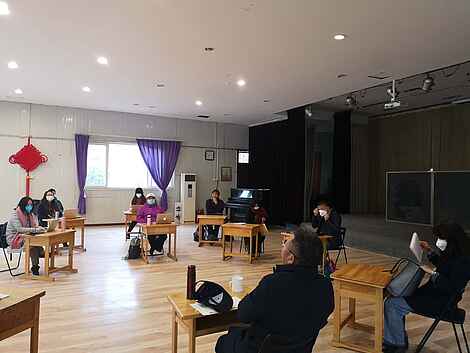by Christof Wiechert, Freelance work Pedagogical Section at the Goetheanum
Having pointed out in an earlier contribution of fourteen points how essential it is, particularly in a time like this, to remain in close contact with the parents and students, using all means available, I would like to add a fifteenth point on the importance of teachers staying in touch as well.
It is strange that we speak of ‘social distancing’ in a time like this. I think the phrase is incorrect because what is actually required is ‘physical distancing’. That we need to keep physical distance to one another is self-evident; but we certainly don’t need social distance, on the contrary we need ‘social togetherness’, a sense of feeling connected even if we can only achieve this with virtual means.
A colleague called my attention to a school that feels powerless in this situation and has done nothing at all in the recent weeks to somehow establish a connection with parents and students.
Since no one knows how long the situation will continue, this omission is certainly risky because once the social ties, the soul-habit body that keeps a school community alive and connected, fall apart, it will be very difficult to re-establish them.
This is why, in Point 4 of my previous contribution, I called for schools to send out an extra weekly newsletter to the parents informing them of what they need to know about the school and about the present invisible work teachers are engaged in. To this information reports and stories written by students could be added, as well as details on how class teachers keep in contact with their students.
I would like to highlight the last point on the list again. We have the technology today to meet virtually in smaller or larger groups. I, for instance, attend an online teachers’ meeting of a school in Asia on a weekly basis. What is important with such meetings is that a moderator is appointed beforehand who leads the discussion, making sure that the speaking time is equally divided and that, at a time like this in particular, everybody who joins the meeting can have their say. Bear in mind that most people sit alone at home; it is important now that everyone is heard.
These virtual meetings have different requirements from physical ones. One needs to listen more intensively to what others say or want to say, because we don’t receive all the sensory impressions that we can usually rely on. We depend on our eyes and ears alone. These meetings are very ‘bare’ and therefore slightly abstract.
Experience has shown, however, that the teachers look forward to these virtual meetings because one has, at least for a limited time, the feeling that one is together, even if it is a substitute for the real thing.
Now more than ever it is important to stand united and talk about essential aspects. From experience I would say that these kinds of meeting should not last more than an hour and a half, rather less.
Many also feel helpless: they don’t know how to use the modern technologies and say they are only just able to cope with their personal laptop.
You can rest assured, however, that there are very competent parents, or colleagues, in the schools who will gladly help with setting up connections. In these virtual meetings you can also talk about the help schools and individual teachers are able to offer. We hear reports from families where both parents have to work from home as well as help their children with their homework, which can soon get too much, particularly because we don’t know for how long this will go on. Other families live in confined spaces and their situation can quickly get stressful. Schools should be contactable in these cases and offer help.
To end with, I would like to say something about the media. Waldorf Schools have good reasons for being critical of media use and media consumption, especially for children. A quick survey has shown that children’s screen time has already risen by 50% in the current situation. Now we are suddenly meant to use them! But how?
The following comparison might make things clearer. Penicillin is a medicine that can save lives when used in serious cases. We also know, however, that it is widely used in cases where its appropriateness is questionable. In my view it is the same with the media: they are often used excessively and unnecessarily but in a situation like this they are helpful!
English translation by Margot M. Saar
